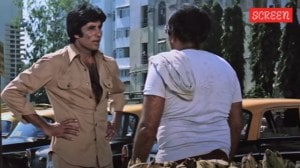‘Impractical for govt to do yearly fire audits, SRA residents should take responsibility for own safety’
It’s not feasible for government to give a free house, manage maintenance and cover tax payments simultaneously, says the SRA CEO.
 Satish Lokhande is the Chief Executive Officer of Maharashtra government’s Slum Rehabilitation Authority. (Express photo by Amit Chakravarty)
Satish Lokhande is the Chief Executive Officer of Maharashtra government’s Slum Rehabilitation Authority. (Express photo by Amit Chakravarty) The idea of a Slum Rehabilitation Authority (SRA) was mooted by the Maharashtra government as a solution to make Mumbai free of slums. Since its inception in 1996, SRA buildings have given permanent houses to 2.50 lakh slum dwellers across the city.
In the early hours of October 6, a medium fire tore through Goregaon’s Jay Bhavani SRA building. The blaze claimed eight lives and left 69 residents injured. Though almost everything in the building was reduced to ashes, SRA Chief Executive Officer Satish Lokhande answers questions raised on the lack of fire safety systems in buildings meant to house former slum dwellers.
Residents of Slum Rehabilitation Authority (SRA) buildings usually complain about the lack of Occupancy Certificate (OC) and fire safety equipment in their buildings, inadequate clean drinking water and insufficient ventilation. Since building plans are approved by the SRA, what goes wrong?
I don’t completely disagree with you, but please consider that SRA was established in 1996. It was relatively basic in its early days too, but underwent numerous modifications and amendments. Before it was called SRA, it was known as the Slum Rehabilitation Development (SRD). The buildings you’re referring to were constructed between 1994 and 1996, making them over 20-25 years old now. These buildings were 7-storey structures, but not high-rises. Fire safety norms then were different too.
It’s worth noting that OCs are only issued once the completion certificate and a No-Objection Certificate (NOC) from the fire department of the BMC (Brihanmumbai Municipal Corporation) have been obtained. The BMC thoroughly examines open spaces and other aspects of the buildings before granting the fire NOC. Only then is the OC provided. However, it’s essential for the residents to take responsibility for maintaining these standards once the fire NOC is issued. It’s worth mentioning that even in well-to-do societies, compliance with these norms can be lacking.
 “Unfortunately, it has been observed that some buildings were occupied without obtaining the necessary OC, particularly during the pandemic. We have initiated a crackdown on unauthorised structures and occupancy by establishing 10 task forces, led by Deputy Collectors, to carry out eviction,” Satish Lokhande said.
“Unfortunately, it has been observed that some buildings were occupied without obtaining the necessary OC, particularly during the pandemic. We have initiated a crackdown on unauthorised structures and occupancy by establishing 10 task forces, led by Deputy Collectors, to carry out eviction,” Satish Lokhande said.
Is there a need to change rules to ensure that buildings have a minimum set of safety standards in place?
Regulations are already established and must be adhered to conscientiously. Conducting a yearly fire audit is an impractical burden for the government. Therefore, it is essential for the residents of SRA buildings to take responsibility for their own safety. Once individuals receive a free house, they must fulfil their obligations and duties. It is not feasible for the government to provide a free house, manage maintenance and cover their tax payments simultaneously.
What do you plan to do about fire safety norms in old buildings, especially after the Goregaon fire?
There are nearly 250 old G+7 (ground-plus-seven-storey) SRA buildings in Mumbai. After the recent fire in Goregaon, we have taken steps to address these safety concerns. Specifically, we plan to install external fire escape ladders in older buildings. The Chief Minister had convened a meeting on this matter. The SRA will allocate funds for installation of spiral fire escape ladders. We have already asked the consultant to prepare an estimate for the project. Once approval is granted, work will commence.
Furthermore, the Municipal Corporation of Greater Mumbai (MCGM) will conduct a comprehensive fire audit of all older SRA buildings. After the audit, pending maintenance funds will be transferred and it will become the responsibility of the respective societies to maintain the buildings.
The government cannot carry out fire audits indefinitely. The audits will need to be performed every six months for buildings constructed before 2010. For buildings constructed after 2010 that fall under the category of high-rise towers (with heights ranging from 70-120 meters, in accordance with the Development Control & Promotion Regulation 2034 regulations), these buildings are subject to stringent fire safety norms. OCs will only be granted after full compliance, including open spaces, fire protection and sprinklers.
Unfortunately, it has been observed that some buildings were occupied without obtaining the necessary OC, particularly during the pandemic. We have initiated a crackdown on unauthorised structures and occupancy by establishing 10 task forces, led by Deputy Collectors, to carry out eviction.
While regularisation of buildings is a separate process, unauthorised occupation is being actively addressed. Notices have been issued to both tenants and developers who allowed occupation without OC. We have identified nearly 585 illegally occupied houses. Penalties are being imposed on developers involved in such cases.
Given the disparity in saleable and rehab buildings, how is SRA making sure that builders construct quality rehab buildings?
SRA buildings do differ from commercial or saleable buildings, primarily due to the cross-subsidy model in place. For rehabilitation purposes, the focus is on providing basic amenities. The rate typically hovers around Rs 3,000 per square foot, which ensures the availability of just essential structures.
In contrast, since they are meant for the open market, the construction cost of saleable buildings tends to be significantly higher. It’s important to note that the quality of earlier SRA buildings may not be at par with what we see today, especially after 2010, when construction of high-rise SRA rehabilitation buildings started.
The primary challenge with SRA buildings lies in their maintenance. Often, amenities like elevators are not used properly. To address this, we have decided to revise the one-time maintenance charges paid by the developer per tenement. The new maintenance fee structure will be based on the building’s height.
For buildings under 32 metres, the maintenance charge will be Rs 40,000; for heights up to 70 metres, it will be Rs 60,000; for heights between 70 and 120 metres, it will be Rs 80,000; and for buildings above 120 metres, it will be Rs 1 lakh. This proposed regulation aims to ensure proper maintenance of buildings. Earlier, maintenance deposits would be transferred to a society’s account after 10 years, but we have decided to transfer it as soon as they obtain the OC.
Why is SRA not following the same pattern as developers and developing slums on its own?
We have introduced a joint venture policy. Under this policy, SRA will act as the planning authority, and government organisations such as MMRDA (Mumbai Metropolitan Region Development Authority), MHADA (Maharashtra Housing and Area Development Authority) and CIDCO (City and Industrial Development Corporation) will take on the role of construction, essentially stepping into the shoes of private developers. Given that these are government agencies, it is possible to consider waiving the premiums typically paid by private developers in this scenario.











